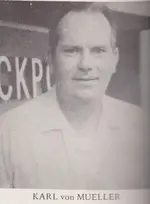TREASURE HUNTER'S YEARBOOK
1970 - '71 A. T. Evans

von MUELLER, KARL; Exanimo Establishment, Segundo, Colorado 81070. One of the best known, and most widely read contributors of information and techniques relating to the field of treasure hunting.
Started relic hunting at Fort Kearney, Nebraska, in 1931-32, by looking for buried guns and jewelry. Started finding money caches in the Oregon Trail campgrounds. and thus began a career as a treasure hunter. Hid most of the loot and toured western states by bus, train and airplane.
Returned to Nebraska to enter medical school bur joined the Army instead. Served one hitch and excused himself to return to civilian life and a career of writing and exploring.
Has written under 23 or more pseudonyms, and is known better as Karl von Mueller, Dean Miller (his real name) or Deek Gladson, the latter being a corruption of his initials and his wife's maiden name, Gladyce Johnson. Has authored numerous books dealing with prospecting and treasure hunting. The TREASURE HUNTER'S MANUAL series comprise his best known books of the adventure field. Started Exanirno Establishment in 1964, as a non-profit publishing firm. Expanded into metal detectors during the fall of that year, and the firm now supplies the professional field in treasure hunting and mining with a complete line of equipment. New books now being printed, or in the process of being completed are: TREASURE OF THE VALLEY OF SECRETS (the documented story of a genuine cave of gold in the Sangre de Cristo mountains), the GOLD DREDGER'S MANUAL (a technical how-to-do -it book for the beginner as well as for the experienced suction dredge operator), ENCYCLOPEDIA OF BURIED TREASURE AND PROSPECTING (a greatly enlarged 2nd edition of the original Encyclopedia of Treasure), THE TREASURE SIGN MANUAL (a completely new dictionary of treasure signs which include hobo, outlaw, Indian, Spanish, Church and other signs), detector manuals (a series of metal detector manuals that provide complex details of individual circuits and extensive how-to-use-them information), and THE DOWSERS MANUAL (a complete treatment of the dowsing or divining field around the world). In addition, negotiations are underway for reprinting the seven published TREASURE HUNTER'S MANUALS, of which all are currently out of print. The eighth edition is approximately half done, and will be published late in 1971.
Just wanted to share a few things about Karl von Mueller that I've ran across. These all reveal a bit more about his life and his accomplishments and also suggest his involvement with the LUE. The first is a brief write-up he received in Western/Eastern Treasures where he wrote for at least 10...

www.treasurenet.com
Here is a partial quote from Karl Von Muellers biography that was published in 1970-71 by Mr. A T Evans. I have seen most of KVM's published books but have never heard of "The Treasure Sign Manual". A quick internet search doesn't show this book either. I mention this because here is another book possibly related to the LUE, which has been quoted as being in print, but appears not to exist. Speculation by one of our members, is that KVM wrote this bibliography himself. If that's so, why mention this book and to what purpose? IMHO, it's to put searchers on the right path and possibly provide a clue when looking for signs in the field.













